|
F6F-5 Early
ProfiPACK
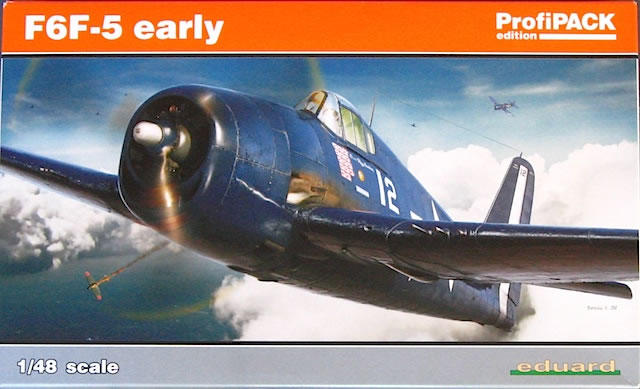
Eduard, 1/48 scale
S u m m a r y : |
Catalogue Number: |
Eduard Kit No.8225 – F6F-5 Early ProfiPACK |
Scale: |
1/48 |
Contents & Media: |
Approximately 126 olive and grey plastic parts (2 unused); 17 clear plastic parts (1 unused); 4 grey resin parts; 1 decal sheet containing markings for 4 aircraft; 1 decal sheet of stencils; 2 sheets of photo-etched brass (1 pre-painted and 1 unpainted); 1 sheet of pre-cut canopy masks; 16 page A4 full colour instruction booklet. |
Price: |
USD$34.95 plus shipping available online from Eduard’s website |
Review Type: |
First Look |
Advantages: |
Excellent base kit; Brassin wheels are beautifully detailed; interesting marking options. |
Disadvantages: |
|
Conclusions: |
A welcome addition to Eduard’s F6F stable g – highly recommended. |
Reviewed by
Brad Fallen

Eduard's 1/48 scale F6F-5 Early ProfiPACK is available online from Squadron.com
With over 12,200 examples manufactured between June 1941 and November 1945 the Grumman F6F Hellcat was the most numerous US Navy fighter of World War 2, and the fourth most produced US fighter of the conflict after the P-51, P-47 and P-40. The basic F6F design remained largely unchanged throughout this production run: as Bert Kinzey points out in ‘F6F Hellcat in Detail and Scale’, ‘the Hellcat was the least modified of any fighter that served for any amount of time’ in the war. When changes were made, they were generally introduced incrementally. This means that while there are obvious differences between the XF6F-1 and XF6F-6 prototypes – the first and last Hellcats – late F6F-3s and early F6F-5s can appear very similar, particularly at first glance.
This developmental continuity has allowed Eduard to deliver a wide range of 1/48 F6F kits with a minimal number of parts. By moulding two different fuselage sprues, two different wing sprues and four different cowling sprues, and then mixing and matching these as required, Eduard has been able to release the following boxings since the series launch in early 2008:
-
F6F-5 late Profipack (2012)
-
Hellcat Mk.II Weekend Edition (2012)
-
F6F-3 Weekend Edition re-release (2013)
While there may be one or two other releases that I’ve missed, this is still a large family of kits. However as the above reviews make clear, there is more to Eduard’s 1/48 Hellcat than an impressive release schedule: it’s also a very good kit. Brett Green concluded in 2010 that the kit is “is beautifully detailed, features excellent surface texture and offers plenty of useful options to the modeler”. Its only challenger for the title of best Hellcat kit is Eduard’s own, more recent 1/72 gem, so unless you fancy improving the older ARII/Otaki or Hasegawa kits (and there are plenty of accessories available to help you do this), then Eduard’s F6F is the best 1/48 option by a considerable margin.
Eduard’s latest addition to this stable is a Profipack boxing of an early F6F-5.
The kit impresses from first glance with its excellent box art of Ray Hawkins’ F6F-5 (kit marking option A) flying above clouds and a burning Japanese aircraft.
The coloured plastic parts are of excellent quality, and suggest Eduard’s moulds are holding up well after five years of busy use. Sprues are provided in two different colours as Eduard continues its transition from olive to grey coloured plastic.
Eduard has delivered an early F6F-5 by combining the following sprues:
- Early fuselage parts featuring the small windows immediately behind the cockpit (sprue C);
- Late cowls (parts J3 and 4); and
- Late cockpit parts (both plastic and photo-etched).
While this combination of features seems reasonable for an early F6F-5, I am not a Hellcat expert and recommend checking your references to determine the specific characteristics of the aircraft you are modeling.
A wide variety of underwing stores – rockets, bombs and fuel tank – is included, but before attaching any of these I would check to see if the chosen ordnance was likely to have been used by the aircraft I was modeling.
The clear parts are also excellent, being thin and very transparent with clearly defined framing.
One of the few limitations of Eduard’s first 1/48 Hellcat releases were the wheels, described by Brett as “the plain narrow style fitted to the prototypes and the earliest production models” and therefore not suitable for late F6F-3s or F6F-5s. However this is not an issue with this kit, because Eduard has included a set of perfectly cast Brassin main wheels and hubs. The late-style tyres have a diamond tread pattern, and the crispness and detail of this as well as the rims and hubs is beautiful.
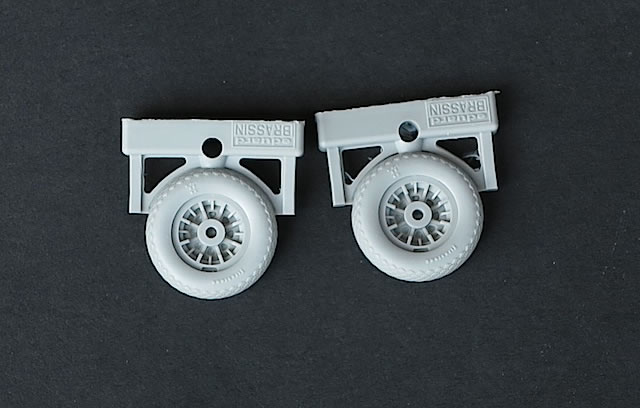
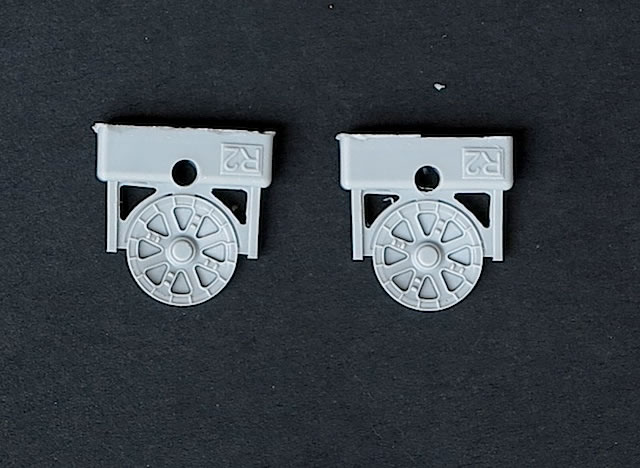
Painted and unpainted photo-etched frets are provided, with the former destined mainly for enhancing the cockpit. The unpainted fret includes bomb fins and a full wiring harness for the engine, which will require careful painting to overcome the 2D effect of etched brass.

Rounding out the package is a sheet of pre-cut masks – arguably not essential for the simple F6F canopy, but I love Eduard masks and will always use them if I can.
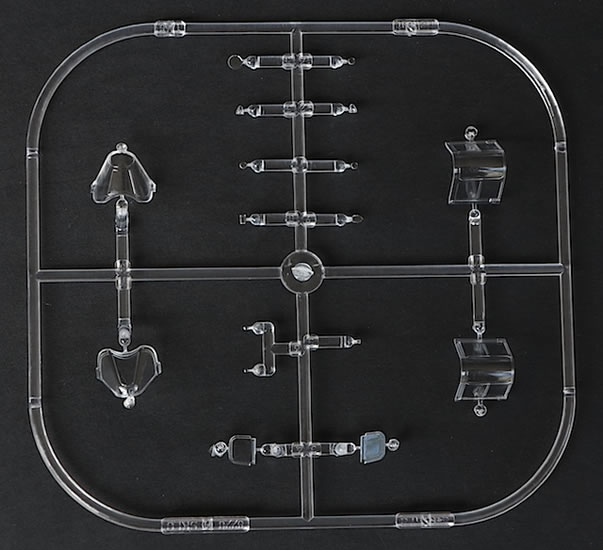
Markings
Eduard provides markings for four F6F-5s, all finished in overall Glossy Sea Blue:
-
BuNo.42158/‘White 12’, flown by LTJG Ray Hawkins (misspelled ‘Hawkings’ on the instruction sheet) of VF-31, USS Cabot, September 1944. Hawkins was the US Navy’s 10th highest scoring ace, and Eduard has depicted his aircraft as decorated with his final tally of 14 kills. Eduard’s depiction of these kill markings, as well as the cluster of other markings beneath the port cockpit, matches well with a photograph I have of this area of ‘White 12’.
-
‘Minsi III’/BuNo.70143, flown by CDR David McCampbell, USS Essex, 25 October 1944. Arguably the most famous Hellcat of all, ‘Minsi III’ was used by McCampbell to score most of his 34 kills, including nine in one mission in October 1944. Kinzey’s book includes a chapter on McCampbell that includes a detailed interview with the ace and photographs of several of his Hellcats; Eduard’s depiction of ‘Minsi III’ closely matches the information in this chapter.
-
‘White 7’/‘Paper Doll’ flown by LT Carl A. Brown Jr of VF-27, USS Princeton, 24 October 1944. Brown used ‘Paper Doll’ to shoot down five Japanese aircraft in a single mission in October 1944; however the aircraft suffered combat damage on the same mission, and was immediately scrapped. I’ve only been able to find a single, largely front-on photograph of ‘Paper Doll’ taxiing along a carrier deck, but from what I can see it appears that Eduard’s representation of the mouth and eyes on the forward cowling is reasonably accurate.
-
BuNo.76384/‘Ripper’ of VF-7, USS Hancock, 1945. This aircraft was fitted with a (presumably replacement) rudder that appeared to be finished in Intermediate Blue. The contrast in colour between the rudder and the rest of the aircraft is clearly visible in photographs.
Eduard’s comprehensive instruction booklet includes full colour four view drawings of each aircraft. Clear instructions are provided for decal placement, including the large number of stencils applied to F6Fs.
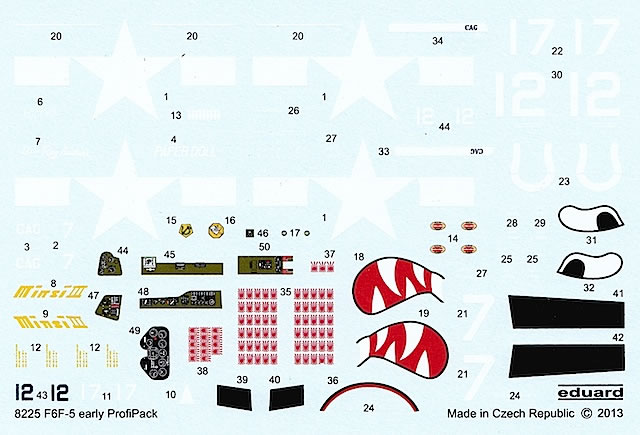
The decals have been produced by Eduard and look good, with no sign of misregistration or other production errors. For those not comfortable with using photo-etch, decals are provided for the instrument panel and side consoles. The stencils are supplied on a smaller, separate sheet.
This is another hard-to-resist Hellcat package from Eduard, combining an excellent base kit with the usual range of Profipack goodies. The Brassin wheels are beautiful, and with careful painting should greatly enhance the final model. The markings for Hawkins’, McCampbell’s and Brown’s machines are welcome, and will be difficult to narrow down to a single choice. Hopefully Eduard will be releasing further F6F kits in this scale, notwithstanding the large number that have already been produced – any chance of a dedicated F6F-5K in 1/48?
References
Bert Kinzey, ‘F6F Hellcat in Detail and Scale’ (Squadron/Signal Publications, 1996).
Thanks to Eduard for the sample and for the images.
Review Text Copyright © 2013 by Brad Fallen
Page Created 8 May, 2013
Last updated
8 May, 2013
Back to HyperScale Main Page
Back to Reviews Page

|
